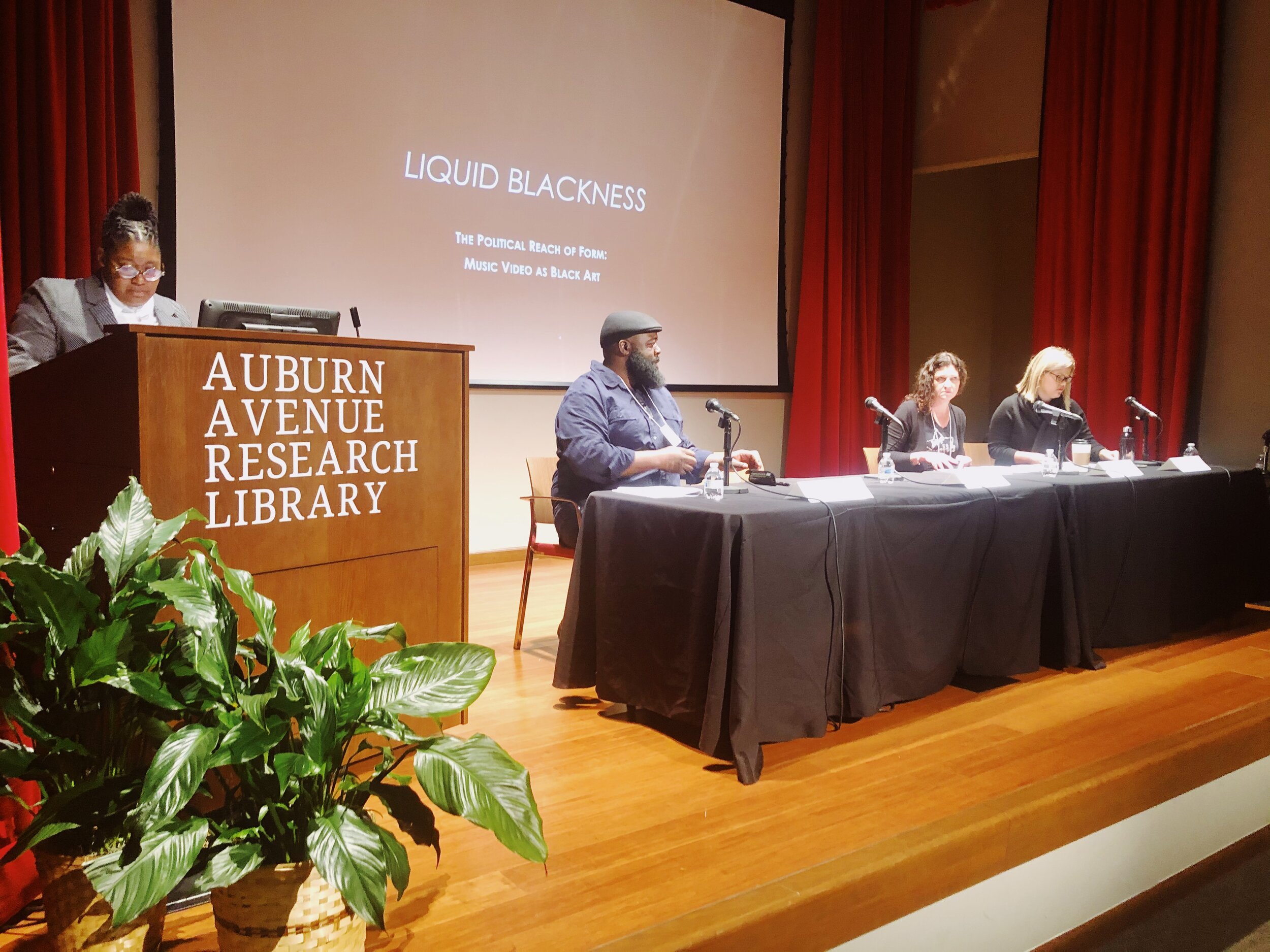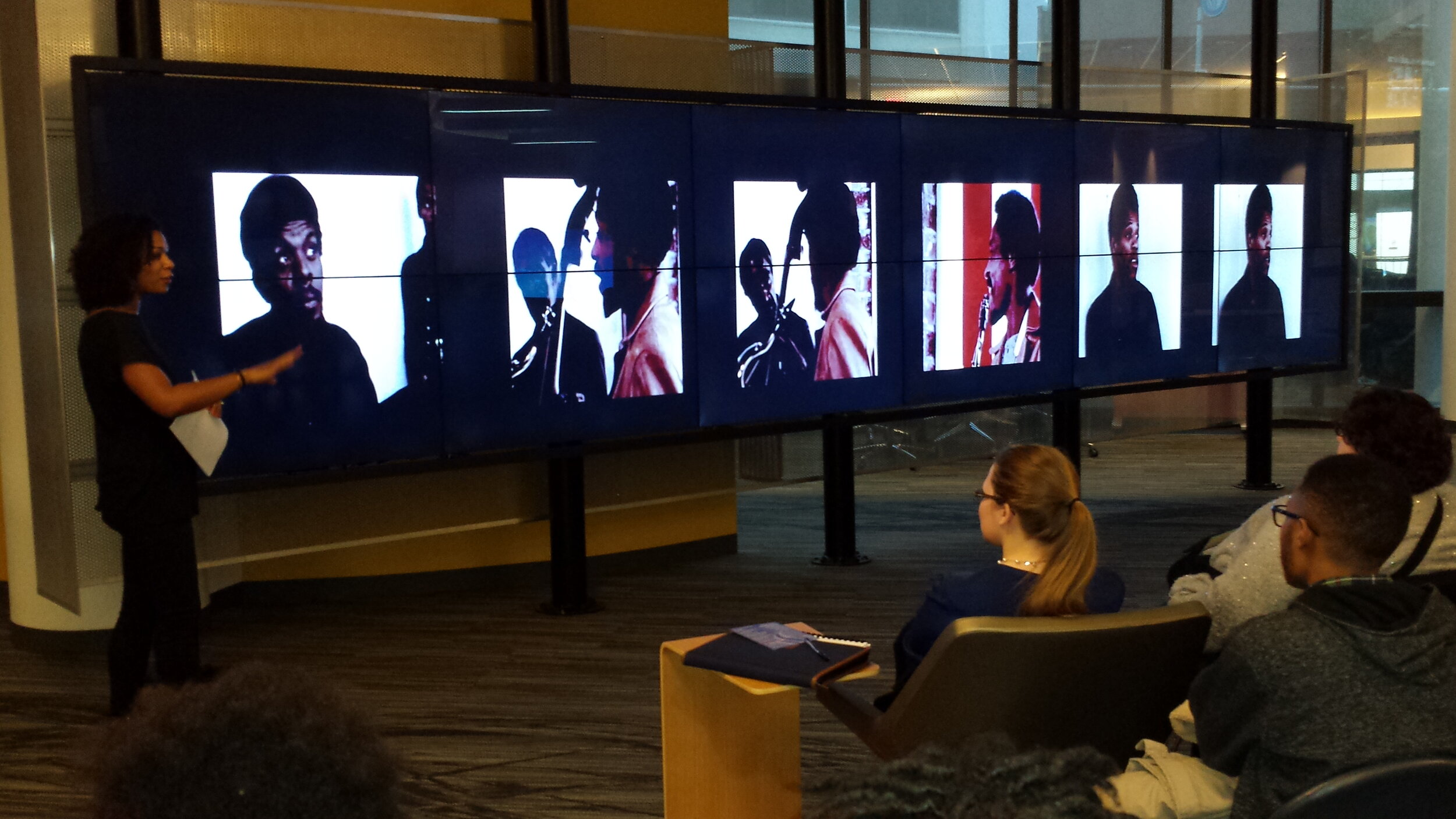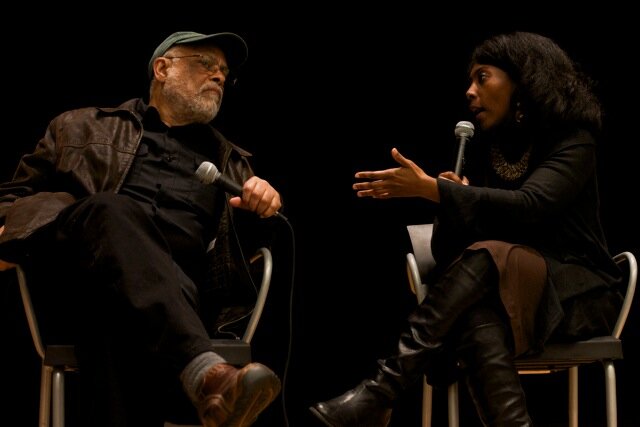WHAT IS LIQUID BLACKNESS?
Standing ovation for Bradford Young, in conversation with Alessandra Raengo for “Bradford Young and the Visual Art of Black Care.” Kopleff Recital Hall, Georgia State University, Atlanta, April 15, 2018.
“liquid blackness” is a term that describes several things at once:
It is the name of a research group, founded in Fall 2013 by Alessandra Raengo, now Distinguished University Professor at Georgia State University, Atlanta, GA, to collaboratively study of radical aesthetics in the visual arts and filmmaking of the Black diaspora, from the 1970s to the present;
the name of an online scholarly journal, published at GSU from 2014 to 2017 and acquired by Duke University Press as liquid blackness: journal of aesthetics and black studies in 2020, which offers a forum for the exploration of experimental methodologies for the formal analysis of blackness in contemporary visual and sonic arts and popular culture at the intersection between the politics and ethics of aesthetics;
a theoretical concept that probes the intersection of Black Studies and aesthetic theory and practice;[1]
an immanent and object-oriented methodology that prioritizes the experience and ethics of the creative practices under consideration, whereby it is the object that each time dictates the terms of its engagement;
an inclusive experimental pedagogy that exposes BIPOC students to the history of their expressive cultures and encourages them to write themselves into these same archives;
a digital archive of primary and secondary materials included in the Library of Congress’s collection of Historic Internet Materials for its “cultural and historical significance”;
a curatorial practice that generates original interpretive frameworks;
a praxis of community-building that gathers like-minded scholars, creatives, institutions, and community partners through its research projects and events.
We deliberately deploy the same term in all of these cases because, for us, “liquidity” describes also a praxis, i.e., a way of doing things, a mode of practicing “black study” and experimenting with improvisational forms of sociality. Early on liquid blackness developed a process whereby, as part of its research projects, the group organizes critical encounters around art that simultaneously addresses scholars, artists, curators, and local communities, which are then developed into open-access publications, where the same research questions are opened up to contributions from the larger academic community.
The liquid blackness research group draws its members from students and alumni of the doctoral program in Moving Image Studies and the MFA in Filmmaking, both in the School of Film, Media & Theatre, College of the Arts, Georgia State University, as well as numerous Film & Media graduates who have benefited from liquid blackness-inspired curriculum since 2013.
liquid blackness members are also drawn from the Editorial and Advisory boards, as well as contributors, of its journal and include art historians, film, music, visual culture, and black studies scholars, curators, and artists.
“Membership” in all cases, describes both institutional assignments (such as graduate assistantships) and, more importantly, a mutually recognized consonance about goals, sensibility, and ethos among scholars, artists, and curators.
In 2020, and concurrent with Duke University Press’s acquisition of liquid blackness: journal of aesthetics and black studies, Dr. Raengo established Liquid Blackness, Limited (LBL), a non-profit dedicated to creating a vibrant, extended, and sustainable community collaboratively studying the intersection of blackness and aesthetics. Through scholarly research and creative projects, open access publications, and public events (symposia, artist talks, teach-ins, art shows) equally directed at scholars, curators, artists, and the broader Atlanta community, LBL mentors the next generation of scholars and creatives of color and/or those fully committed to the agenda of Black Studies.
[1] For an initial articulation of “liquid blackness” as a theoretical concept see Alessandra Raengo, “Blackness, Aesthetics, Liquidity,“ liquid blackness 1, no. 2 (April 2014): 5-18.


liquid blackness Events
liquid blackness presents: Third Measure (2023)
Composed by Anna Winter, Josh Cleveland, and Cedric Simmons, Third Measure draws inspirations from Julius Eastman’s concept of organic music to channel the ensemblic and archival practices of the liquid blackness group. Building on Jenn Nkiru’s understanding of the archive as “something that has to be constantly creating and recreating,” and, following her inspirational practice in Rebirth is Necessary, Third Measure offers itself as a gathering place that refuses closure, ownership, and individuation. An archive in the making as much as it is an archive of the making, Third Measure is more invested in sharing than in explaining. Images and sounds come together as jurisgenerative ensembles that never conclusively land but produce instead a constant folding and unfolding, a care-full and grate-full sliding forward that calls upon “lineages to come.”
a. Early Theory
The expression “liquid blackness” began as a classroom prompt, to foster a conversation about Nick Hooker’s 2008 video for Grace Jones’s song Corporate Cannibal. Although its first utterance was merely descriptive, it immediately emerged as a powerful concept which has become more complicated over time and has been enriched by the research projects conducted by the liquid blackness group.
The first liquid blackness “manifesto,” with a brief essential reading list, written by Professor Raengo, was published on this website in the Summer of 2013 and reprinted in the summer of 2015 in the exhibition catalog for Mark Bradford’s show Scorched Earth, curated by Connie Butler, at the Hammer museum in L.A. The same manifesto was used for a call for work for artists invited to the first liquid blackness Symposium held in April 2014, keynoted by Professor Derek Conrad Murray and curator Hamza Walker. The Symposium coincided also with the publication of the 2nd issue of the liquid blackness journal containing the first essay outlining the theoretical underpinning of the concept of “liquid blackness” by Professor Raengo as well as a series of responses to the invited artists’ works.
One of the goals of “liquid blackness” is to affect a shift from prescriptive notions of black aesthetics to ideas of blackness as aesthetics. In this sense, “liquid blackness” describes the thick complex of material forces and conditions that have to be negotiated in order for blackness to act expansively and to be free to explore its own genius and possibilities.
“liquid blackness” is an unavoidably ambiguous concept and serves as a pressure point between identity politics and materialist immanence, lived experience and form, politics and aesthetics, the diagnostic and the critical. We embrace this ambiguity because we think it’s a productive place to start, and with the belief that, as written back in 2013, there is no question about blackness that is not worth asking.


liquid blackness Research
b. Practice
As a research group, liquid blackness began in the Fall 2013 to facilitate the co-hosting of the “L.A. Rebellion: Creating a New Black American Cinema” tour in conjunction with Emory’s Department of Film and Media Studies. Since then, the group has treated each of these events as opportunities to develop more research questions and expand the scope of the group’s collective study. For example, after partaking in an experimental collective study of one of the most celebrated and yet elusive films of the L.A. Rebellion, Larry Clark’s Passing Through (1977) in 2015, the group continued to explore the art and politics of the jazz ensemble with an event organized around Barbara McCullough’s 2017 film Horace Tapscott: Musical Griot, a “poetic meditation” on the strength of African American music and activism embodied in the history of Los Angeles through the life of musician, composer and community activist Horace Tapscott (1934-1999), which included a screening and a masterclass with the experimental filmmaker. Similarly, our research project on “Black Ontology and the Love of Blackness,” centered on Arthur Jafa’s 2013 film Dreams Are Colder than Death (April 2016) was followed by a research project, symposium, screening, and artist talk with Jafa’s frequent collaborator Kahlil Joseph entitled, “Holding Blackness in Suspension: The Films of Kahlil Joseph” (October 2016) and two years later with “Figuring Suspension: A Study of Visual Recording Artist Storyboard P” (February 2018), a project about the flex dancer who features in many of Joseph’s and Jafa’s works. In April 2018 the group completed “Bradford Young and the Visual Art of Black Care” (April 2018), which included a screening, artist talk, and masterclass, followed by a screening and community conversation, “Holding Place. Taking Flight: Childish Gambino, Terence Nance, Bradford Young, and Grace Jones,” that brought together the work of experimental artists who operate in both fine art and popular cultural spaces and consider the world-making potential of black art. In April 2019 the group hosted Jenn Nkiru for an event called “Jenn Nkiru’s Panafrican Imagination: Black Studies as Aesthetic Practice,” followed by a talk and masterclass with Elissa Blount Moorhead (November 2020) titled “Facing The Band: Elissa Blount Moorhead and the (Ana)Architectures of Community Ties preceded by a teach-in designed to familiarize audiences with the artist’s work. In the Spring of 2022, another teach-in, titled “Figure/Ground: Abstraction and Subject Matter in Kevin Jerome Everson’s Artmaking Practice,” prepared Atlanta audiences for Everson’s visit as inaugural College of the Arts Ferrer Visiting Artist in March 2022, followed in May by a screening of his installation Hazel (2022).
In September 2021, liquid blackness hosted a series of roundtable discussions among contributors to the first 2 issues of liquid blackness: journal of aesthetics and black studies, titled “Atonal Symphonies: Conversations on Blackness and Liquidity at the Threshold of Thinking and Making,” which then engendered a short experimental film directed and edited by Josh Cleveland, written by Alessandra Raengo and with concept and sound design from Cedric Simmons.
During the summer of 2020, liquid blackness founder Alessandra Raengo partnered with colleagues Aggie Ebrahimi Bazaz, Sojourna Collier, and Jade Petermon for AMPLIFY: Media Arts for Collective Strength, a showcase and series of reflective discussions of Georgia State University School of Film, Media, and Theater students' creative videos and writings focused on fostering a critical dialogue about moving images a tool for advocacy, protest, reflection, healing, and community-building.
An account of the beginning of the research group appears in Alessandra Raengo, “Encountering the Rebellion: liquid blackness Reflects on the Expansive Possibilities of the L.A. Rebellion Films,” in L.A. Rebellion: Creating a New Black Cinema, ed. Allyson Nadia-Field, Jan-Christopher Horak, and Jacqueline Stewart (Oakland: University of California Press, 2015) and Raengo’s “Black Study @ GSU: The Album,” liquid blackness: journal of aesthetics and black studies 5, no. 1 on “liquidity,” April 2021: 5-25.


liquid blackness Events
c. Praxis
Throughout these projects, the group has developed a collaborative and intrinsically interactive approach to arts and visual culture that have involved audiences from other Atlanta institutions (Emory University, Georgia Tech, Spelman, Morehouse, in particular) with community members, which has offered ways to experiment with the possibilities of intra- and extra-institutional study as well as the mingling of theory, practice, and praxis.
As a whole, the work of the liquid blackness group upholds the values of hospitality, reciprocity, collaboration, intergenerational mentorship, modeled after the aspirational praxis of “black study.”

